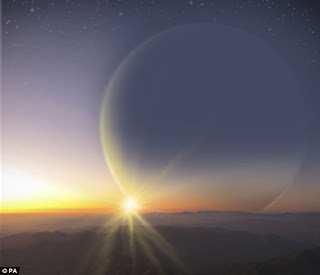A team of amateur astronomers from around the world has discovered evidence for 42 alien planets, including a Jupiter-size world that could potentially be habitable, it was revealed today.
The team, organised online via the planethunters website, analysed data from Nasa's Kepler Space telescope.
Moons like the one depicted in the film Avatar may be among the most common places to find alien life, scientists believe.
Astronomers came to the conclusion after identifying up to 15 new planets orbiting the life-friendly 'habitable zones' of stars.
All are giant gaseous worlds similar in size to Jupiter or Neptune.
While such planets would not themselves be suitable for Earth-like life, they could be circled by moons on which there are forests, oceans and living creatures, researchers now believe.
Pandora, the fictional moon in Avatar, is just such a world.
So far only one of the 15 newly discovered objects has been confirmed as an exoplanet with 99.9% certainty.
The rest still fall into the category of 'candidate' planets while further evidence is collected.
The confirmed planet, known as PH2 b, orbits a sun-like star in the constellation Cygnus several hundred light years away.
Astronomer Dr Chris Lintott, from Oxford University, a member of the international team behind the discovery, said: 'There's an obsession with finding Earth-like planets but what we are discovering with planets such as PH2 b is far stranger.
'Jupiter has several large water-rich moons. Imaging dragging that system into the comfortably warm region where the Earth is.
'If such a planet had Earth-size moons, we'd see not Europa and Callisto but worlds with rivers, lakes and all sorts of habitats: a surprising scenario that might just be common.
'It may be that the most common habitable worlds are moons around Jupiter and Neptune-size planets rather than rocky planets as in our own solar system.'
Members of the public helped astronomers identify the candidate exoplanets by logging onto the planethunters.org website on their home computers.
The Planet Hunters project invites 'citizen scientists' to spot graph patterns signifying the tell-tale dip in brightness as planets pass in front of their parent stars.
Follow-up work with the Keck telescope in Hawaii provided the proof that PH2 b is almost certainly a genuine planet.
More than 40 volunteers are credited in a paper on the research published online by the Astrophysical Journal.
One, retired police office Roy Jackson, 71, from Birtley near Gateshead, said: 'It is difficult to put into words, the pleasure, wonderment and perhaps even pride that I have in some small way been able to assist in the discovery of a planet.'
Another, electronics engineer Mark Hadley from Faversham, said: 'Now when people ask me what I achieved last year I can say I have helped discover a possible new planet around a distant star. How cool is that?'
Planet Hunters lead scientist Professor Debra Fisher, from Yale University in the US, said: 'We are seeing the emergence of a new era in the Planet Hunters project where our volunteers seem to be at least as efficient as the computer algorithms at finding planets orbiting at habitable zone distances from the host stars.
'Now, the hunt is not just targeting any old exoplanet; volunteers are homing in on habitable worlds.'
Before the latest finds, 19 other exoplanets had already been located in habitable zones.
Also known as the 'Goldilocks zone', this is the orbital path where temperatures are not too hot or cold but "just right" to permit liquid surface water.
Dr Ji Wang, another Planet Hunters scientist from Yale University, said: 'We can speculate that PH2 b might have a rocky moon that would be suitable for life.
'I can't wait for the day when astronomers report detecting signs of life on other worlds instead of just locating potentially habitable environments.
'That could happen any day now.'
You are here :
Home
» Science
» Space
» Amateur astronomers find 42 new planets - including a world that could hold life
Subscribe to:
Post Comments (Atom)






0 comments:
Post a Comment